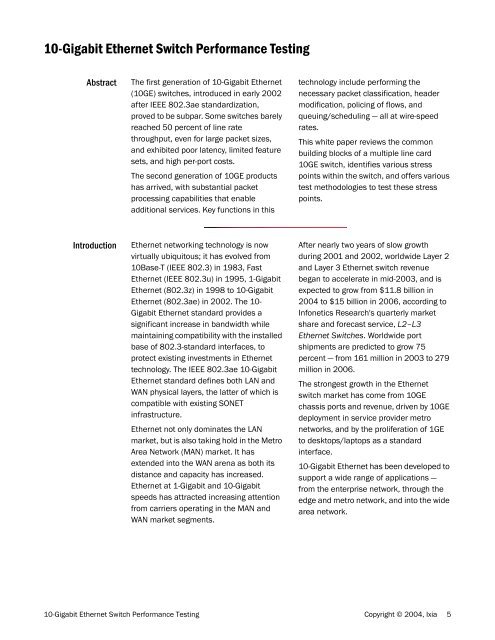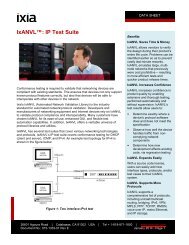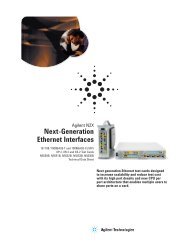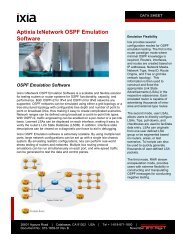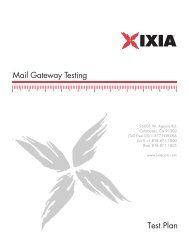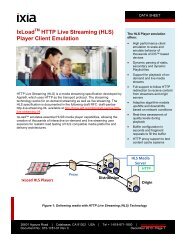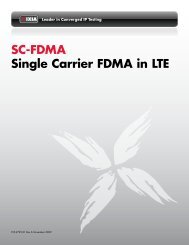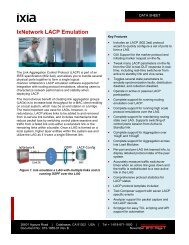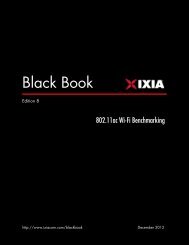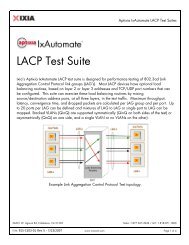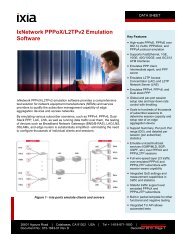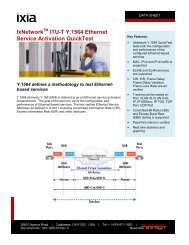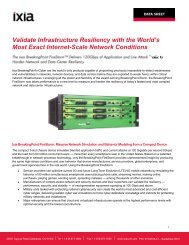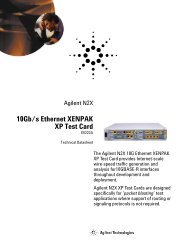10-Gigabit Ethernet Switch Performance Testing - Ixia
10-Gigabit Ethernet Switch Performance Testing - Ixia
10-Gigabit Ethernet Switch Performance Testing - Ixia
You also want an ePaper? Increase the reach of your titles
YUMPU automatically turns print PDFs into web optimized ePapers that Google loves.
<strong>10</strong>-<strong>Gigabit</strong> <strong>Ethernet</strong> <strong>Switch</strong> <strong>Performance</strong> <strong>Testing</strong><br />
Abstract The first generation of <strong>10</strong>-<strong>Gigabit</strong> <strong>Ethernet</strong><br />
(<strong>10</strong>GE) switches, introduced in early 2002<br />
after IEEE 802.3ae standardization,<br />
proved to be subpar. Some switches barely<br />
reached 50 percent of line rate<br />
throughput, even for large packet sizes,<br />
and exhibited poor latency, limited feature<br />
sets, and high per-port costs.<br />
The second generation of <strong>10</strong>GE products<br />
has arrived, with substantial packet<br />
processing capabilities that enable<br />
additional services. Key functions in this<br />
Introduction <strong>Ethernet</strong> networking technology is now<br />
virtually ubiquitous; it has evolved from<br />
<strong>10</strong>Base-T (IEEE 802.3) in 1983, Fast<br />
<strong>Ethernet</strong> (IEEE 802.3u) in 1995, 1-<strong>Gigabit</strong><br />
<strong>Ethernet</strong> (802.3z) in 1998 to <strong>10</strong>-<strong>Gigabit</strong><br />
<strong>Ethernet</strong> (802.3ae) in 2002. The <strong>10</strong>-<br />
<strong>Gigabit</strong> <strong>Ethernet</strong> standard provides a<br />
significant increase in bandwidth while<br />
maintaining compatibility with the installed<br />
base of 802.3-standard interfaces, to<br />
protect existing investments in <strong>Ethernet</strong><br />
technology. The IEEE 802.3ae <strong>10</strong>-<strong>Gigabit</strong><br />
<strong>Ethernet</strong> standard defines both LAN and<br />
WAN physical layers, the latter of which is<br />
compatible with existing SONET<br />
infrastructure.<br />
<strong>Ethernet</strong> not only dominates the LAN<br />
market, but is also taking hold in the Metro<br />
Area Network (MAN) market. It has<br />
extended into the WAN arena as both its<br />
distance and capacity has increased.<br />
<strong>Ethernet</strong> at 1-<strong>Gigabit</strong> and <strong>10</strong>-<strong>Gigabit</strong><br />
speeds has attracted increasing attention<br />
from carriers operating in the MAN and<br />
WAN market segments.<br />
technology include performing the<br />
necessary packet classification, header<br />
modification, policing of flows, and<br />
queuing/scheduling — all at wire-speed<br />
rates.<br />
This white paper reviews the common<br />
building blocks of a multiple line card<br />
<strong>10</strong>GE switch, identifies various stress<br />
points within the switch, and offers various<br />
test methodologies to test these stress<br />
points.<br />
After nearly two years of slow growth<br />
during 2001 and 2002, worldwide Layer 2<br />
and Layer 3 <strong>Ethernet</strong> switch revenue<br />
began to accelerate in mid-2003, and is<br />
expected to grow from $11.8 billion in<br />
2004 to $15 billion in 2006, according to<br />
Infonetics Research's quarterly market<br />
share and forecast service, L2–L3<br />
<strong>Ethernet</strong> <strong>Switch</strong>es. Worldwide port<br />
shipments are predicted to grow 75<br />
percent — from 161 million in 2003 to 279<br />
million in 2006.<br />
The strongest growth in the <strong>Ethernet</strong><br />
switch market has come from <strong>10</strong>GE<br />
chassis ports and revenue, driven by <strong>10</strong>GE<br />
deployment in service provider metro<br />
networks, and by the proliferation of 1GE<br />
to desktops/laptops as a standard<br />
interface.<br />
<strong>10</strong>-<strong>Gigabit</strong> <strong>Ethernet</strong> has been developed to<br />
support a wide range of applications —<br />
from the enterprise network, through the<br />
edge and metro network, and into the wide<br />
area network.<br />
<strong>10</strong>-<strong>Gigabit</strong> <strong>Ethernet</strong> <strong>Switch</strong> <strong>Performance</strong> <strong>Testing</strong> Copyright © 2004, <strong>Ixia</strong> 5


